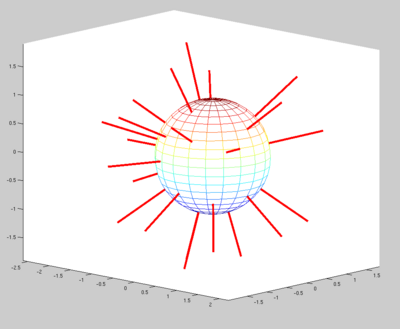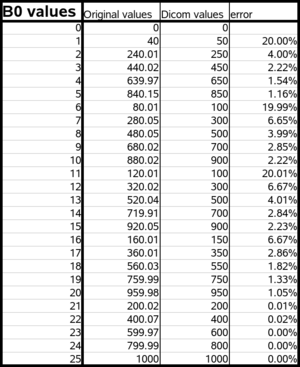Difference between revisions of "Projects:DicomToNrrdForDTI"
| Line 1: | Line 1: | ||
| − | Dicom conversion for DTI data | + | = Dicom conversion for DTI data = |
| Line 10: | Line 10: | ||
The DTI sequence is a 25 directions with variable b-values plus one B0 image. | The DTI sequence is a 25 directions with variable b-values plus one B0 image. | ||
| − | [[Image:OrigDataBVal.png|400px|right]] | + | [[Image:OrigDataBVal.png|thumb|400px|right]] |
| − | [[Image:OrigGradDir3D.png|400px|left|none]] | + | [[Image:OrigGradDir3D.png|thumb|400px|left|none|Original 25 gradient directions]] |
| Line 19: | Line 19: | ||
We loaded this dicom dataset into the “Dicom DWI loader” module in Slicer3. This module creates a NRRD header based on the information read from the dicom header. We compared the values outputted by the Slicer3 modules with the ones gave to us by the people who designed the DTI sequence. | We loaded this dicom dataset into the “Dicom DWI loader” module in Slicer3. This module creates a NRRD header based on the information read from the dicom header. We compared the values outputted by the Slicer3 modules with the ones gave to us by the people who designed the DTI sequence. | ||
| − | = bValues = | + | === bValues === |
| + | |||
| + | |||
| + | The protocol specifies a bvalue maximum of bMax = 1000. Then the bvalue for each directions is bMax times the square of the gradient direction magnitude. | ||
| + | |||
| + | We found out that the bvalues that we read from the dicom header are rounded up to the nearest 50. However people from Siemens told us that the actual bvalues used for the acquisition are the correct ones. The bvalue is modified only when written in the dicom header. It seems that if a user does not have the protocol, it's not possible to find to proper, exact bvalues. | ||
| + | |||
| + | [[Image:BValComparison.png|thumb|400px|left]] | ||
| + | [[Image:BvalTable.png|thumb|300px|right|Bvalues comparison]] | ||
Revision as of 17:10, 29 April 2008
Home < Projects:DicomToNrrdForDTIDicom conversion for DTI data
Introduction
In this page we present some results on the conversion from dicom data to DTI. Working with this new dataset, we noticed differences between the dicom header information and the ones from the original protocol designed for this study. In this page, we want describe and discuss these differences.
The data we worked with have been acquired with a Siemens 3T Tim Trio.
The DTI sequence is a 25 directions with variable b-values plus one B0 image.
Data comparison
We loaded this dicom dataset into the “Dicom DWI loader” module in Slicer3. This module creates a NRRD header based on the information read from the dicom header. We compared the values outputted by the Slicer3 modules with the ones gave to us by the people who designed the DTI sequence.
bValues
The protocol specifies a bvalue maximum of bMax = 1000. Then the bvalue for each directions is bMax times the square of the gradient direction magnitude.
We found out that the bvalues that we read from the dicom header are rounded up to the nearest 50. However people from Siemens told us that the actual bvalues used for the acquisition are the correct ones. The bvalue is modified only when written in the dicom header. It seems that if a user does not have the protocol, it's not possible to find to proper, exact bvalues.



